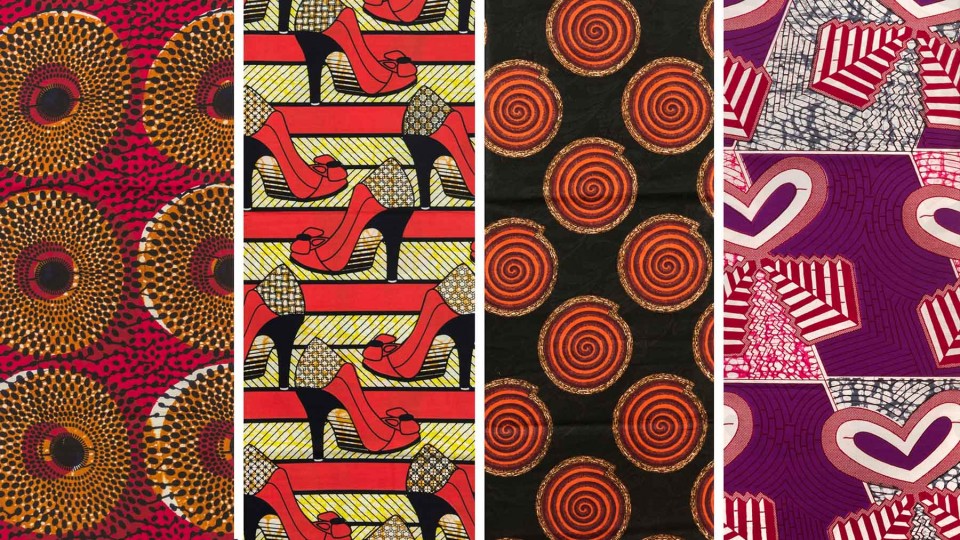
“Wandering Spirit: African Wax Prints” documents the history and development of the handmade designs and patterns on textiles that originated in Indonesia and were copied and industrialized by Europeans and exported to Africa. The exhibition, curated by Dr. Gifty Benson and organized by ExhibitsUSA/Mid-America Arts Alliance of Kansas City, Missouri, traces the developmental pathway of the African wax print and tells how these fabrics reflect the stories, cultures and personalities of the people who wear them. The exhibition opens Oct. 24 in the Hillestad Gallery in the Home Economics Building on the University of Nebraska–Lincoln’s East Campus and runs through Nov. 23.
The batik process was invented in eighth-century China, then expanded to India on the coast of Coromandel. The technique was imported to Java by traders in the twelfth and thirteenth centuries. Batik is a Javanese word that refers to a technique of wax-resist dyeing, by which a pattern is made on both sides of cotton fabric with warm liquid wax applied by a tjanting, a small brass cup with a spout. After the wax cools and solidifies, the cloth is dyed with a primary color and the wax is then removed, revealing the pattern where the wax had once been.
J.B.T. Prévinaire, a Dutch cotton printing mill owner, was instrumental in developing a machine that could print imitation batiks industrially. In 1854, he unveiled “La Javanaise,” a converted French printing machine that could print an imitation of the Javanese batik using resin instead of wax. Despite the technological advance, “La Javanaise” produced imperfections in the print that did not appeal to the Javanese buying public, so European printers found themselves searching for new markets around the world. After many years of transcontinental exploratory travels and investigations, they identified Africa as the new potential market for their wax prints.
The success of wax prints in parts of Africa is driven by many factors including culture, taste and the styling preferences of African consumers. Patterns in textiles and in many other applied forms serve as important systems of communication, sending messages and referencing local proverbs and mythologies. Textiles and clothing can also convey a person’s social status and position, political convictions, ambition, marital status, ethnicity, age, gender and group affiliations. The names and stories associated with the fabrics differ from country to country and from region to region. The same fabric may have different names in different countries, depending on the way traders and consumers interpret and relate to motifs found in the cloth.
The history of the African wax print is a history embedded in colonial trade routes and dependent on globalization in the post colonial era. Though not originally African, these textiles are widely associated with African culture and society, and loved and identified as Africans' own.
About The Robert Hillestad Textiles Gallery
The Robert Hillestad Textiles Gallery is devoted to the exhibition of textiles–from art to apparel, from East to West, from past to present, and from emerging artists to the acclaimed. Named in honor of Professor Emeritus Dr. Robert Hillestad, the gallery mounts a continuing series of exhibitions throughout each year that spotlight the diverse traditions and practices of the textile arts.
About ExhibitsUSA
This exhibition is toured by ExhibitsUSA, a national program of Mid-America Arts Alliance. ExhibitsUSA sends more than 25 exhibitions on tour to over 100 small- and mid-sized communities every year. These exhibitions create access to an array of arts and humanities experiences, nurture the understanding of diverse cultures and art forms, and encourage the expanding depth and breadth of cultural life in local communities. For more about ExhibitsUSA, email MoreArt@maaa.org or visit http://www.eusa.org.
About Mid-America Arts Alliance
Mid-America Arts Alliance (M-AAA) strengthens and supports artists, cultural organizations and communities throughout our region and beyond. We achieve this primarily through our national traveling exhibition programs, innovative leadership development, and strategic grant making. We are especially committed to enriching the cultural life of historically underserved communities by providing high quality, meaningful, and accessible arts and culture programs and services. Each year M-AAA’s programs reach one million people. We believe in more art for more people. Additional information about M-AAA is available at http://www.maaa.org.
More details at: http://http://cehs.unl.edu/textilegallery/